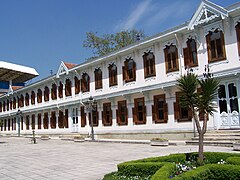Yildiz Palace
| Yıldız Palace | |
|---|---|

Yıldız Palace
|
|
| General information | |
| Type | Palace |
| Location | Istanbul, Turkey |
| Coordinates | 41°02′58″N 29°00′40″E / 41.04944°N 29.01111°ECoordinates: 41°02′58″N 29°00′40″E / 41.04944°N 29.01111°E |
| Completed | 1880 |
Yıldız Palace (Turkish: Yıldız Sarayı, IPA: [jɯɫˈdɯz saɾaˈjɯ]) is a vast complex of former imperial Ottoman pavilions and villas in Istanbul, Turkey, built in the 19th and early 20th centuries. It was used as a residence by the Sultan and his court in the late 19th century.
Yıldız Palace, meaning "Star Palace", was built in 1880 and was used by the Ottoman Sultan Abdülhamid II. The area of the palace was originally made of natural woodlands and became an imperial estate during the reign of Sultan Ahmed I (1603-1617). Various sultans after Ahmed I enjoyed vacationing on these lands and Sultans Abdülmecid I and Abdülaziz built mansions here.
In the late 19th century, Sultan Abdülhamid II left Dolmabahçe because he feared a seaside attack on the palace, which is located at the shore of the Bosporus strait. He expanded the Yıldız Palace and ordered the renowned Italian architect Raimondo D'Aronco to build new buildings to the palace complex. When he moved there, the palace became the fourth seat of Ottoman government (the previous ones were the Eski Saray (Old Palace) in Edirne, and the Topkapı and Dolmabahçe Palaces in Istanbul.)
The palace is a complex of buildings including the State Apartments (Büyük Mabeyn), Şale Pavilion, the Malta Pavilion, the Çadır Pavilion, the Yıldız Theater and Opera House, the Yıldız Palace Museum, and the Imperial Porcelain Factory. The Yıldız Palace Gardens are also a popular public site among the residents of Istanbul. A bridge connects the Yıldız Palace with the Çırağan Palace on the Bosporus through this garden.
...
Wikipedia

